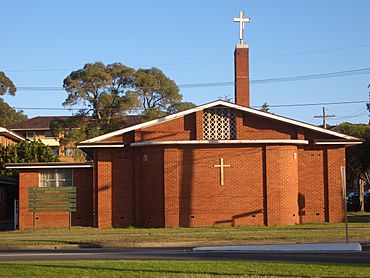Russell Lea facts for kids
Quick facts for kids Russell LeaSydney, New South Wales |
|||||||||||||||
|---|---|---|---|---|---|---|---|---|---|---|---|---|---|---|---|

St Andrews Anglican Church
|
|||||||||||||||
| Population | 5,001 (2016 census) | ||||||||||||||
| Postcode(s) | 2046 | ||||||||||||||
| Elevation | 20 m (66 ft) | ||||||||||||||
| Location | 8 km (5 mi) west of Sydney CBD | ||||||||||||||
| LGA(s) | City of Canada Bay | ||||||||||||||
| State electorate(s) | Drummoyne | ||||||||||||||
| Federal Division(s) | Reid | ||||||||||||||
|
|||||||||||||||
Russell Lea is a small suburb in the inner-west part of Sydney, New South Wales, Australia. It is about 8 kilometres west of the main business area of Sydney. Russell Lea is part of the City of Canada Bay local government area.
This quiet suburb sits on the western shore of Iron Cove, which is part of the Parramatta River. You can find large homes right by the water here. There are also many traditional Federation-style houses.
Contents
History of Russell Lea
Russell Lea gets its name from Russell Barton. He was one of the first people to settle in this area. Barton was a farmer, mine owner, and a politician. He created a large property called the "Russell Lea Estate" on a piece of land that was about 24-hectare (60-acre) big.
Early Land Ownership
Long ago, Russell Lea was part of a huge farm called Five Dock Farm. This farm belonged to a surgeon named John Harris. He came to the new colony in 1790. Harris quickly gained a lot of land from the Crown. By 1806, he owned Five Dock Farm. This farm included all the land between Iron Cove and Hen and Chicken Bay. It was a very large area, about 600 ha (1,500 acres).
John Harris sold Five Dock Farm to Samuel Lyons in 1836. Lyons was a well-known auctioneer in Sydney. He then divided Five Dock Farm into smaller, but still large, estates. These estates were between 12 to 24 ha (30 to 60 acres) in size. This made way for grand houses to be built. Some of these large properties later became suburbs themselves, like Drummoyne House and Abbotsford. Russell Barton's grand home, Russell Lea, was also built on one of these estates.
Who Was Russell Barton?
Russell Barton was born in England in 1830. He moved to Australia with his family when he was young. They settled on a farm in South Australia. Barton was very skilled and could do many jobs. He was a farmer, a horse trainer, a builder, and more.
In 1874, he invested in the Cobar mine. He became the managing director of this mine. Barton was very good at mining. He was even elected to the boards of 11 different mining companies. From 1880 to 1886, Barton was a member of Parliament for the area of Bourke. During this time, he built his impressive Victorian Italianate mansion, Russell Lea. The suburb we know today is named after his estate.
Growth and Development
In the late 1800s, it became easier to travel around Drummoyne. This led to more homes being built. By 1874, there was a regular horse bus service for local people. In 1881, the original Gladesville Bridge was finished. This bridge connected the Drummoyne area to the inner parts of Sydney. It was the only road between Port Jackson and the lower Parramatta River until the Sydney Harbour Bridge opened in 1932.
Soon after, the Iron Cove Bridge was built in 1882. It crossed Iron Cove. In 1890, a tram line connected Five Dock and Leichhardt. By 1902, the local governments of Five Dock and Drummoyne joined together to form the Borough of Drummoyne. At this time, about 2,800 people lived in the region. Russell Barton's Russell Lea estate stayed whole until 1913. Then, it was divided into smaller plots and sold.
Local Landmarks
Russell Lea has a few important places:
- Russell Lea Infants School is one of the oldest buildings in the area.
- Campbell Park is a large soccer field. It is home to the Abbotsford Juniors Football Club.
- The main roads that go through Russell Lea are Lyons Road and Hampden Road.
Population Information
According to the 2016 census, Russell Lea had a population of 5,001 people. Of these, 2,621 (52.4%) were female, and 2,380 (47.6%) were male.


